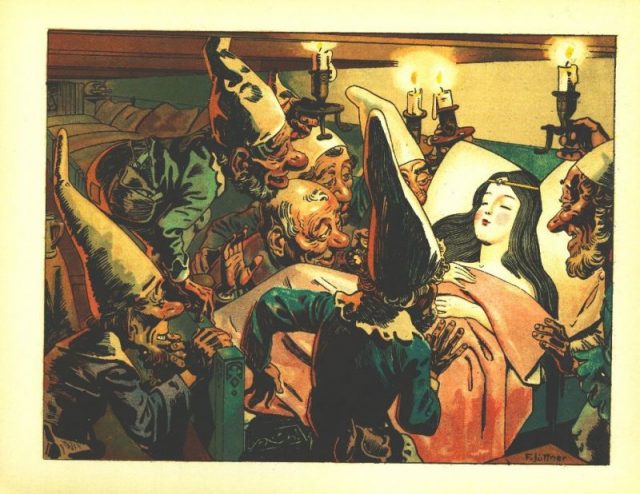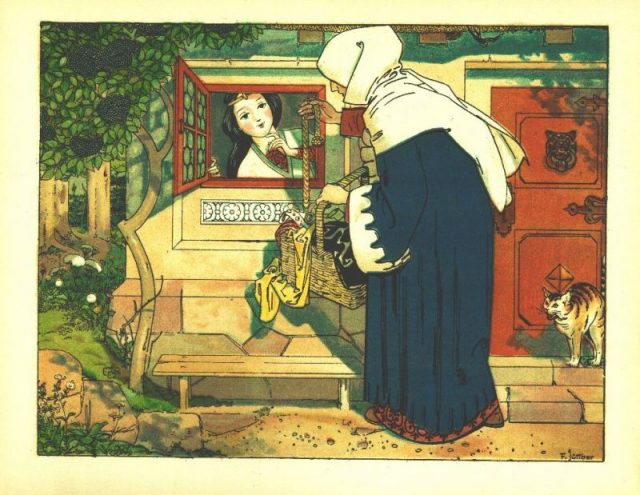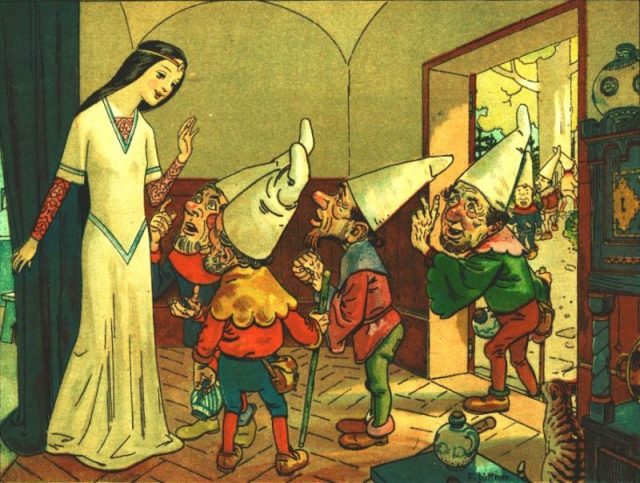
Oh, Snow White, that classic, if a little retro, fairytale of good triumphing over evil. It’s a sweet story of an innocent young beauty who is banished by a vain, cruel, and jealous stepmother and who, with the help of seven lovable dwarfs, ultimately finds everlasting true love. Walt Disney turned the fable into the first full-length animated musical feature film in 1937. Snow White and the Seven Dwarfs is to this day one of the top-10 films of all time (adjusted for inflation), beloved by generations of children.
It turns out the American animator left out a few gruesome details. Disney’s well-known Snow White is a sanitized version of the original German Brothers Grimm fairytale, which was a lot more, well, grim.
Jacob and Wilhelm Grimm didn’t actually come up with the story of Snow White or Cinderella, Rapunzel, or any other storybook princess associated with their (and now Disney’s) name, for that matter. The Grimms were German scholars, researchers, and authors who collected folktales that were part of a rich oral tradition, having been passed down from generation to generation of women telling the stories to pass the time. In 1812, they published the collection as Nursery and Household Tales.

The dwarfs find Snow White asleep
Despite its title, the book was not originally intended for children. The text included violence, incest, sex, and perhaps most deadly of all—footnotes. In the Cinderella story, for instance, the stepsisters cut off their toes and heels in order to fit into the glass slipper.
In “Little Snow-White,” as the original story was called, the Evil Queen asks a hunter to take Snow White into the forest to kill, as happens also in the movie. (In the original version, the child is also only 7 years old, as opposed to Disney’s 14. Neither seems old enough to consider marriage.)
In the Grimm version, the Queen orders the huntsman to bring back Snow White’s internal organs, saying “Kill her, and as proof that she is dead bring her lungs and liver back to me.”
He kills a boar instead, and brings back to the Queen the boar’s lungs and liver—which the Queen thinks belongs to Snow White and so promptly eats. Ewww!

The Queen visits Snow White
“The cook had to boil them with salt, and the wicked woman ate them, supposing that she had eaten Snow-White’s lungs and liver,” as the Grimm brothers wrote.
The Queen tricks Snow White three separate times in the Grimm version. The first time, she has Snow White try on a corset, which is so tight, Snow White passes out. (The dwarfs save her by cutting the laces.) The second time, she sells Snow White a poisonous comb, which the young girl puts in her hair, causing her to pass out. (The dwarfs take it out.) The third time the Queen tricks her with the same poisonous apple we see in the Disney film.
Having fainted and presumed dead, young Snow-White is placed in a glass coffin in both book and movie. When the Prince happens by in the Grimm version, he insists on taking the deceased beauty away, even though he’s never met her. The dwarfs hesitantly agree, but as they are carrying her coffin out of their house, one of them stumbles. Jostled from her resting place in the coffin, Snow White spits out the apple lodged in her throat and is immediately revived. Without the influence of the Prince’s kiss.
In movie and in folklore, Snow White and the Prince fall in love and get married (never mind that in the original tale, Snow is only 7 years old). In the movie, the seven dwarfs chase the Evil Queen into the forest, where she tumbles off a cliff—with a push from a convenient lightning strike—and falls to her death.

The dwarfs warn Snow White
In the book version, the Queen attends their wedding where she is meted out a just punishment of dancing to her death. (Perhaps this last was thought up by a 19th century noblewoman forced to dance endlessly to the 1812 version of Bruno Mars’s “Marry You.”)
The more Grimm version of the Queen’s death goes like this: “They put a pair of iron shoes into burning coals. They were brought forth with tongs and placed before her. She was forced to step into the red-hot shoes and dance until she fell down dead.”
You can see why Disney wanted to clean up that unsavory image!
E.L. Hamilton
https://www.thevintagenews.com/2018/04/18/snow-white-story/
In 2013, the United States Patent and Trademark Office issued a trademark to Disney Enterprises, Inc. for the name "Snow White" that covers all live and recorded movie, television, radio, stage, computer, Internet, news, and photographic entertainment uses, excluding literary works of fiction and nonfiction.
“See for yourself what the genius of Walt Disney has created in his first full length feature production,” proclaimed the original trailer for Snow White and the Seven Dwarfs, released on February 4, 1938.
Based on the famous fairy tale by the Brothers Grimm, Snow White opened with the Wicked Queen asking her magic mirror the question “Who is the fairest one of all?” The mirror gives its fateful answer: Snow White, the queen’s young stepdaughter. Ordered by the queen to kill the young princess, a sympathetic woodsman instead urges Snow White to hide in the forest; there she encounters a host of friendly animals, who lead her to a cottage inhabited by the Seven Dwarfs: Sleepy, Dopey, Doc, Sneezy, Grumpy, Bashful and Happy. Eventually, in the classic happy ending viewers would come to expect as a Disney trademark, love conquers all as the dwarfs defeat the villainous queen and Snow White finds love with a handsome prince.
Walt Disney’s decision to make Snow White, which was the first animated feature to be produced in English and in Technicolor, flew in the face of the popular wisdom at the time. Naysayers, including his wife Lillian, warned him that audiences, especially adults, wouldn’t sit through a feature-length cartoon fantasy about dwarfs. But Disney put his future on the line, borrowing most of the $1.5 million that he used to make the film. Snow White premiered in Hollywood on December 21, 1937, earning a standing ovation from the star-studded crowd. When it was released to the public the following February, the film quickly grossed $8 million, a staggering sum during the Great Depression and the most made by any film up to that time.
Critics were virtually unanimous in their admiration for Snow White. Charlie Chaplin, who attended the Hollywood premiere, told the Los Angeles Times that the film“even surpassed our high expectations. In Dwarf Dopey, Disney has created one of the greatest comedians of all time.” The movie’s innovative use of story, color, animation, sound, direction and background, among other elements, later inspired directors like Federico Fellini and Orson Welles. In fact, Welles’ Citizen Kane features an opening shot of a castle at night with one lighted window that is strikingly similar to the first shot of the Wicked Queen’s castle in Snow White.
Disney won an honorary Academy Award for his pioneering achievement, while the music for the film, featuring Snow White’s famous ballad, “Some Day My Prince Will Come” and other songs by Frank Churchill, Larry Morey, Paul J. Smith and Leigh Harline, was also nominated for an Oscar. The studio re-released Snow White for the first time in1944, during World War II; thereafter, it was released repeatedly every decade or so, a pattern that became a tradition for Disney’s animated films. For its 50th anniversary in 1987, Snow White was restored, but cropped into a wide-screen format, a choice that irked some critics. Disney released a more complete digital restoration of the film in 1993. Its power continues to endure: In June 2008, more than 60 years after its U.S. release, the American Film Institute chose Snow White and the Seven Dwarfs as the No. 1 animated film of all time in its listing of “America’s 10 Greatest Films in 10 Classic Genres.”
https://www.history.com/this-day-in-history/disney-releases-snow-white-and-the-seven-dwarfs
The psychology of Snow White: What does she hope for? "Someday my prince will come." By this Snow White means that she lives her own being as incomplete, pending the arrival of one who will "complete" her. That is, she lives her own being as "not-with" (even though she is in some sense "with" the seven men, Bill, Kevin, Clem, Hubert, Henry, Edward and Dan). But the "not-with" is experienced as stronger, more real, at this particular instance of time, than the "being-with." ... [or] in the area of fears, she fears Mirrors
Apples
Poisoned Combs.
-Donald Barthelme, Snow White (New York: Bantam Books, 1968), pp. 70, 17.
MIRCEA ELIADE HAS STATED that the popularity and power of fairy tales in modern life might be because the folktale "takes up and continues 'initiation' " on the level of the imagination.' In other words, the universal appeal of a traditional narrative form like the folktale is not simply that it allows for amusement or a temporary escape from the banalities of ordinary life but, because at a deeper level, it preserves a vision of human life as fundamentally an initiatory process: "what is called 'initiation' coexists with the human condition, that every existence is made up of an unbroken series of 'ordeals,' 'deaths,' and 'resurrections'... .."
Eliade's suggestion that the fairy tale functions as an "easy doublet" for initiatory myths and rites and, consequently, reaffirms the ultimate religious significance of life and the real possibility of a "happy ending,"3 has been echoed by scholars such as Max Lathi who wrote that:
The charm of the fairy tale is explained not only by the fact that everything usually comes out all right in the end . . . It is more than mere wish-fulfillment literature. The religious historian Mircea Eliade once said that the hearers of fairy tales, without being aware of it, experience a sort of initiation not entirely unlike that in the customs of some primitive peoples. .. .How correct this scholar's assertion is can be shown in any folk fairy tale.
My intention is not to discuss these general speculations, but rather to examine the proposition that fairy tales not only vaguely suggest initiatory themes at the level of individual symbols but that the narrative form of a fairy tale as a particular structural constellation of symbols basically reveals an initiatory pattern. To read the full article, click HERE.
Girardot, N. J. “Initiation and Meaning in the Tale of Snow White and the Seven Dwarfs.” The Journal of American Folklore, vol. 90, no. 357, 1977, pp. 274–300. JSTOR, www.jstor.org/stable/539520. Accessed 5 Aug. 2020.